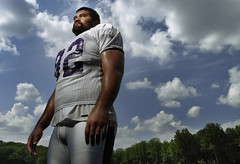 After a long summer, NFL Football finally lights up again this weekend. And one of my favorite players is Baltimore defensive tackle Haloti Ngata.
After a long summer, NFL Football finally lights up again this weekend. And one of my favorite players is Baltimore defensive tackle Haloti Ngata. I got to photograph him as a rookie shortly before his first-ever start as a Raven in 2006. It was for a feature, and ran lead on A-1 the day he made his NFL debut. I had a few minutes to shoot him in full sun after a long practice, so I knew I would need to knock out the sun to build up some decent light.
My first thought upon seeing the 6'4", 345 behemoth:
"We're gonna need a bigger gobo …"
__________
One of my first instincts when shooting a daytime portrait in full sun is to get rid of the sun. And since I live in the northern hemisphere, the best place to find a large spot of shade is always on the north side of a building. The sky is full daylight, of course, so exposing for it (or a little down, as I did here) will give you a nice, dark subject on which to add light.
The light in this case was my well-worn White Lightning 600, which was forever my go-to light for overpowering sun. Still, it is not powerful enough to beat sun at any real distance, so I tend to work in close.
When working in close, you also do not have to use a huge modifier to get decent quality portrait light. For that reason I chose a beauty dish, which gave me the added advantage of being fairly resistant to the wind.
[TIP: When shooting a sequoia-sized NFL lineman, probably better not to refer to your light as a "beauty dish."]
Actually, no worries in Ngata's case. He was super nice to me even after a long practice. And those 300-lb+ lineman take a beating in the late summer heat.
Shooting lit in the sun is like what they do to Marines at boot camp: Knock 'em down, and build 'em back up. And putting your subject in shade gives you total control over the ratio between ambient-lit sky and strobe-lit subject.
The Game Plan
Get your subject in shade. Start at a 250th of a second o get your most flash-friendly aperture at which you can sync a full-pop flash. Then choose the aperture that gives you the best looking background.
Now, adjust the distance and/or power level on the flash until you have a properly exposed subject and you are good to go. It is a very quick process, and no flash meter is needed.
Study the Films
This is a very interesting photo for me to look back at, because it illustrates the lighting learning curve that has developed on the web in the last three years. In short, when I took this photo I loved it -- in large part because of the light.
Now, while I still like the photo, all I see is missed opportunities.
There are so many things I could have -- should have -- done that would have amped this photo. Even by adding just one SB-800 speedlight, which I am 100% sure I stupidly had sitting idle in my waist pack, I had a couple of cool options.
One, I could have simply stuck it on the hot shoe for a little on-axis fill. Without a background to catch the hard shadow, an on-camera flash can work great against off-camera light. Here's an example.
But even better, I could have just stuck the flash on the ground (camera right) just behind Ngata, aimed straight up, to throw some cool uplight into his massive arms. Start with the flash on full power, zoomed to 105mm to control spill and max out the lumens. Then quickly dial it down to where you want after one visual test.
And don't even get me started on two speedlights as kickers. You could combine the two add-ons above, or throw both flashes on the ground behind Ngata (one on each side). Each solution would have looked way better than the shot up top, and totally different from each other.
Flat Foreheads of the World, Unite!
It's like McNally says, you whack your forehead with your palm enough times while thinking of what you shoulda done, and it can get pretty flat.
But your lighting gets better.




0 comments:
Post a Comment